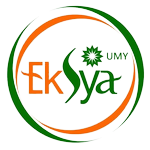Consumer Preferences in the Selection of Muslim Fashion Products in Indonesia
DOI:
https://doi.org/10.18196/jiebr.v2i2.26Keywords:
Fashion Muslim, Consumer PreferencesAbstract
The development of Muslim fashion has created a community that calls itself the hijabers community, namely a group of Muslim women who wear fashionable clothes with various styles and knick-knacks for their headscarves. On the other hand, people's preferences for the importance of halal fashion are the main factors in choosing fashion products, namely convenience, product quality, and price. The research method used is library research or literature study, which contains theories relevant to the research problem. The results of this study illustrate that the trend of Muslim fashion is a positive thing because more and more people are using Muslim clothing, meaning that one of the goals of da'wah is to call for the obligation to cover the genitals to be helped by the trend. Not only that, trends and hijrah motifs play a role in determining Muslim consumer behavior in buying Muslim clothing because both are some factors that influence consumer decisions, especially personal and psychological factors.
References
Alhabeeb, M. J. (1996). Teenagers’ money, discretionary spending and saving. Journal of Financial Counseling and Planning, 7(413), 123–132.
Alim, S. A., Mawardi, M. K., & Bafadhal, A. S. (2018). Pengaruh Persepsi Label Halal dan Kualitas Produk Terhadap Keputusan Pembelian Produk Fesyen Muslim ( Survei pada Pelanggan Produk Zoya Muslim di Kota Malang ). Jurnal Administrasi Bisnis, 62(1), 127–134.
Anafarhanah, S. (2019). Tren Busana Muslimah Dalam Perspektif Bisnis Dan Dakwah. Alhadharah: Jurnal Ilmu Dakwah, 18(1), 81. https://doi.org/10.18592/alhadharah.v18i1.2999
Ansori, H. (2020). Faktor Perilaku Konsumen Terhadap Keputusan Pembelian Busana Muslim dan Muslimah di Toko Atikah Collection123 Perumnas Kelurahan Tanjung Karang Permai Kecamatan Sekarbela Kota Mataram. In Paper Knowledge . Toward a Media History of Documents.
Astuti, S. A. M. (2016). Fenomena Hijabers dan Relevansinya dengan Nilai-Nilai Pendidikan Islam Bagi Mahasiswi Jurusan Pendidikan Agama Islam Fakultas Ilmu Tarbiyah Dan Keguruan Universitas Islam Negeri Sunan Kalijaga Yogyakarta. UIN Sunan Kalijaga Yogyakarta.
Ayunda, A., Mutmainah, L., & Huda, N. (2019). Analisis Terhadap Perilaku Konsumen Produk Fashion Muslim. JEBA (Journal of Economics and Business Aseanomics), 3(2), 243–270. https://doi.org/10.33476/jeba.v3i2.962
Chintamany, Y. (2009). Landasan Konseptual Perencanaan dan Perancangan Jogja Fashion Center DI Yogyakarta. S1 Thesis, UAJY, 16–32.
Fikry, A., & Ahmad, M. R. (2019). Malaysian’s Young Consumer Preferences of Hijab. Journal of Reviews on Global Economics, 8, 916–924. https://doi.org/10.6000/1929-7092.2019.08.78
Frank, R. H. (2015). Microeconomics and behavior (9th ed.). Mc Graw-Hill Education.
Grant, I. J., & Stephen, G. R. (2005). Buying behaviour of “tweenage†girls and key societal communicating factors influencing their purchasing of fashion clothing. Journal of Fashion Marketing and Management, 9(4), 450–467. https://doi.org/10.1108/13612020510620812
Gustiawati, S., Mukri, Indriya, & Harisah. (2021). Penerapan Konsep Syariah Dalam Pengembangan Bisnis Ikm Fashion Muslim Di Era 4.0. AL-IQTISHADY : Jurnal Ekonomi Syariah, 2(1), 73–88.
Hassan, S. H., & Harun, H. (2016). Factors influencing fashion consciousness in hijab fashion consumption among hijabistas. Journal of Islamic Marketing, 7(4), 476–494.
Hendariningrum, R., & Susilo, E. M. (2008). Fashion dan Gaya Hidup: Identitas dan Komunikasi. Ilmu Komunikasi, 6(2), 25–32. http://jurnal.upnyk.ac.id/index.php/komunikasi/article/viewFile/38/42
Ibrahim, N. A., Ghazali, Z., & Zakaria, Z. (2011). ‘Influence of socialization agents on fashion consciousness.’ International Journal of Business and Social Science, 2(14), 127–134.
Jamil, N. (2016). “You Are My Garmentâ€: Muslim Women, Religious Education and Self-Transformation in Contemporary Singapore. Asian Studies Review, 40(4), 545–563. https://doi.org/10.1080/10357823.2016.1228044
Jannah, I. N., & Kodrat, D. S. (2021). Analysis of the consumer preferences of attributes of Rajini Modest Fashion Products. KnE Social Sciences, 2021, 93–103. https://doi.org/10.18502/kss.v5i5.8801
Jumaidah, S. (2020). Analisis Tingkat Kepuasan Konsumen dalam Memilih Fashion Busana Muslimah di Family Jaya Store. UIN Sulthan Thaha Saifuddin.
Kautish, P., Khare, A., & Sharma, R. (2020). Influence of values, brand consciousness and behavioral intentions in predicting luxury fashion consumption. Journal of Product and Brand Management, 30(4), 513–531. https://doi.org/10.1108/JPBM-08-2019-2535
Kim, J., Park, J., & Glovinsky, P. L. (2018). Customer involvement, fashion consciousness, and loyalty for fast-fashion retailers. Journal of Fashion Marketing and Management, 22(3), 301–316. https://doi.org/10.1108/JFMM-03-2017-0027
KNEKS. (2021). Strategi Nasional Pengembangan Industri Halal Indonesia. https://kneks.go.id/storage/upload/1631178852-KNEKS_STRA_HALAL_BOOK_01_compressed (1).pdf
Kotler, P., & Armstrong, G. (2018). Principles of Marketing (7th ed.). Pearson Education Limited.
Kotler, P., & Keller, K. L. (2016). Marketing Manajemen. Global Editions.
Lailiya, S. M. (2020). Implikasi Trend Fashion Terhadap Perilkau Sosial Calon Pendidik (Studi Kasus pada Mahasiswa Program Studi Pendidikan Agama Islam IAIN Kediri). Skripsi, IAIN Salatiga, 1(Viii), 1–98.
Leung, A. C. Y., Yee, R. W. Y., & Lo, E. S. C. (2015). Psychological and Social Factors of Fashion Consciousness: An Empirical Study in the Luxury Fashion Market. Research Journal of Textile and Apparel, 19(3), 58–69. https://doi.org/10.1108/RJTA-19-03-2015-B008
Maurya, S., & Sharma, S. (2014). Fashion awareness and peer pressure among adolescents. Asian Journal of Home Science, 9(2), 375–379. https://doi.org/10.15740/has/ajhs/9.2/375-379
MD, U. W., & Achiria, S. (2020). Peran Trend dan Motif HijrahTerhadap Pembelian Busana Muslimah Di Kota Palu. Jurnal Ilmu Ekonomi Dan Bisnis Islam, 1(2), 1–17. https://doi.org/10.24239/jiebi.v1i2.9.1-17
Nisya, K. (2013). Faktor yang Mempengaruhi Konsumen Terhadap Keputusan Membeli Busana Muslimah Modern. November, 119–137.
Rathnayake, C. V. (2011). An empirical investigation of fashion consciousness of young fashion consumers in Sri Lanka. Young Consumers, 12(2), 121–132. https://doi.org/10.1108/17473611111141588
Sakkthivel, A. M., Shameem, B., & Mushtaq, S. (2020). Does media influence fashion consciousness of Muslim women consumers: Evidences from the United Arab Emirates. International Journal of Business Innovation and Research, 22(4), 523–545. https://doi.org/10.1504/IJBIR.2020.109036
Solomon, M. R. (2018). onsumer Behavior: Buying, Having, and Being (17th ed.) Harlow. Pearson Education Limited.
Sujarweni, V. W. (2014). Metodeologi Penelitian. Pustaka Baru Perss.
Sukardani, P. S., Setianingrum, V. M., & Wibisono, A. B. (2020). Halal Lifestyle: Current Trends In Indonesian Market. 226(Icss), 334–339. https://doi.org/10.2991/icss-18.2018.68
Sukardi. (2013). Metodologi Penelitian Pendidikan Kompetensi dan Praktiknya. PT Bumi Aksara.
Suparno, C. (2016). Analisis Persepsi dan Sikap Individu untuk Memilih Produk Hijab. Media Ekonomi Dan Manajemen, 31(1), 48–55.
Taylor, S. L., & Cosenza, R. M. (2002). Profiling later aged female teens: Mall shopping behavior and clothing choice. Journal of Consumer Marketing, 19(5), 393–408. https://doi.org/10.1108/07363760210437623
Yakup, D., & Sevil, Z. (2011). An impirical study on the effect of family factor on consumer buying behaviours. Asian Social Science, 7(10), 53–62. https://doi.org/10.5539/ass.v7n10p53
Zeb, H., Rashid, K., & Javeed, M. B. (2011). Influence of Brands on Female Consumer ‟ s Buying Behavior in Pakistan. 2(3).
Downloads
Published
How to Cite
Issue
Section
License
Copyright (c) 2022 Journal of Islamic Economic and Business Research

This work is licensed under a Creative Commons Attribution-NonCommercial 4.0 International License.
Journal of Islamic Economic and Business Research has CC-BY NC or an equivalent license as the optimal license for the publication, distribution, use, and reuse of scholarly work for non-commercial purpose. The non-commercial use of the article will be governed by the Creative Commons Attribution license as currently displayed on Creative Commons Attribution-NonCommercial 4.0 International License
Creative Commons License




